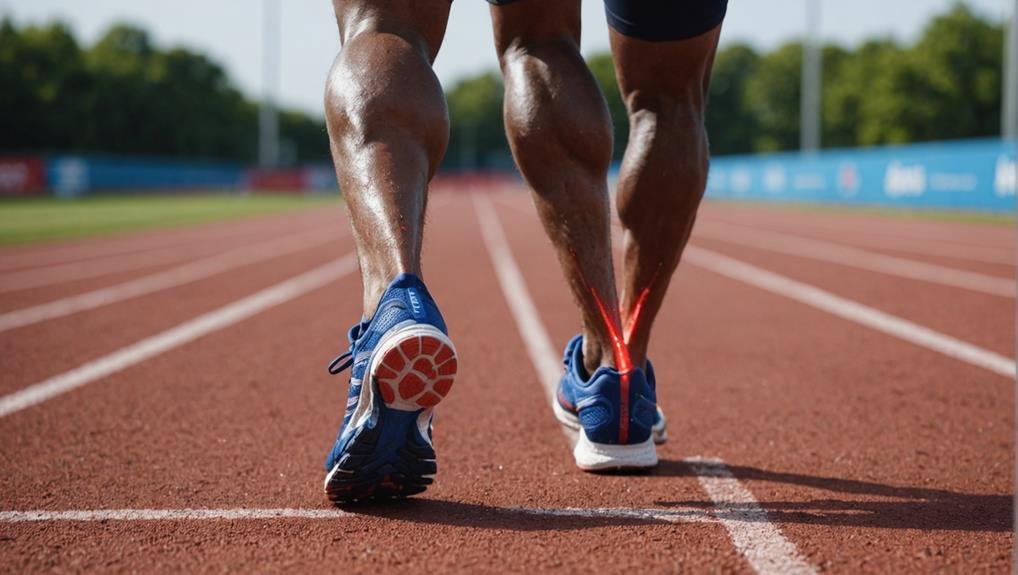You’ve probably heard of shin splints if you’ve ever experienced a dull ache along your lower leg after a run or intense workout. They might seem minor, but ignoring the symptoms can lead to more serious issues. You might start with mild tenderness or soreness that worsens during activity and eases with rest. However, there’s more to understanding these symptoms beyond just the pain. Could there be underlying causes that are often overlooked? Let’s explore the signs and discover what your body might tell you.
Key Takeaways
- Shin splints cause dull, aching pain along the front of the shins.
- Tenderness and discomfort are common on the inner part of the lower leg.
- Pain worsens during exercise but typically improves with rest.
- Mild swelling may occur, making the shin area appear puffy.
- Persistent soreness can indicate a more severe condition if untreated.
Understanding Shin Splints

Shin splints are common, especially for athletes and those engaged in repetitive physical activities. You might experience pain along the shin bone or tibia, often due to inflammation of the muscles, tendons, and surrounding tissue. This condition can cause tenderness in the lower leg, making it uncomfortable to touch.
It’s crucial to grasp the symptoms of shin splints, as they typically include a dull or aching pain in the front of your shins. This discomfort might worsen during exercise but often improves with rest.
Shin splints can be particularly problematic for athletes like runners, dancers, and military recruits. The repetitive stress on the shinbone and surrounding tissues leads to inflammation and subsequent pain.
It’s essential to differentiate shin splints from other conditions, such as stress fractures, by noting where the pain occurs, typically on the inner part of the lower leg.
Proper diagnosis and treatment are essential. Rest, ice, and stretching exercises can help alleviate the symptoms. Supportive footwear and physical therapy are also recommended to strengthen muscles and prevent re-injury. Understanding shin splints can guide you toward effective treatment and swift recovery.
Common Symptoms
When dealing with shin splints, you’ll often notice tenderness, soreness, or pain along the inner part of your shinbone. This discomfort typically arises in the shin area and can be particularly noticeable during physical activity. As you continue to engage in your favorite sports or exercises, you might detect mild swelling in the lower leg, which can add to your overall discomfort. It’s critical to pay attention to these signs, as ignoring them could lead to more severe problems like a stress fracture.
Here’s a quick list of common symptoms to watch out for:
- Pain and Tenderness: You’ll feel tenderness or pain along the inner shinbone, especially during or after physical activity.
- Soreness: Persistent soreness in the shin area that doesn’t seem to improve with rest.
- Swelling: Mild swelling in the lower leg can occur, making the area appear puffy or tender to the touch.
- Increased Pain: If the pain becomes continuous, it could suggest a more severe issue requiring evaluation by a healthcare provider.
Don’t disregard these symptoms, as they can escalate if left untreated. Addressing them early can help prevent potential complications.
Pain Progression

As you continue to engage in physical activities without addressing shin splint symptoms, the pain can progress from mild tenderness to severe soreness along the shinbone. This pain progression isn’t just vital; it can be a warning sign. If left unchecked, shin splint pain might lead to stress reactions or even fractures. Symptoms may initially subside with rest, but if the underlying cause remains unaddressed, the pain could become continuous.
To help you monitor the pain progression, here’s a quick reference table:
| Symptom Stage | Action Needed |
|---|---|
| Mild Tenderness | Rest and assess activity levels |
| Severe Soreness | Seek advice; consider underlying issues |
| Continuous Pain | Consult a healthcare provider |
Pain along the inner shinbone is a common symptom and should prompt a visit to a healthcare provider. Monitoring the pain progression and recognizing these symptoms early can prevent more severe conditions. If your shin splint pain persists or worsens, seeking medical attention is essential. Ignoring these signs can lead to more significant injuries, affecting your ability to continue physical activities. Addressing the underlying cause is key to avoiding continuous discomfort and potential stress reactions or fractures.
Diagnosis Methods
When you’re experiencing symptoms of shin splints, your doctor will start with a review of your medical history and a thorough physical exam. They’ll assess tenderness along your shin bone and may use imaging tests like X-rays or MRIs to rule out other conditions. Additionally, they might perform gait analysis and functional tests to understand your movement patterns and muscle strength.
Medical History Review
A thorough medical history review is essential in diagnosing shin splint symptoms. Assessing past injuries is crucial, as they can significantly influence your susceptibility to developing shin splints. Evaluating your activity levels and understanding the pain patterns you experience will help identify potential triggers. Your exercise routine, footwear choices, and training intensity are important factors that healthcare providers consider during this review.
Here’s what to expect during a medical history review:
- Past Injuries: Your history of injuries, especially related to the lower limbs, can provide insights into recurring issues contributing to your shin splint symptoms.
- Activity Levels: Understanding how frequently and intensely you engage in physical activities helps gauge whether your current routine contributes to the pain.
- Pain Patterns: Identifying when and where you feel pain can help pinpoint the underlying cause, whether it’s during exercise or at rest.
- Previous Treatments and Relevant Medical Conditions: Discussing what treatments you’ve tried before and any existing medical conditions can help you craft an effective treatment plan.
Physical Examination Techniques
Understanding your medical history is just the start of diagnosing shin splints. During a physical examination, your healthcare provider will focus on palpating the shinbone to pinpoint areas of tenderness. Unlike other conditions, this helps determine if you’re dealing with shin splints.
They’ll also likely conduct functional tests to assess any gait abnormalities or muscle weaknesses contributing to your symptoms. These tests are essential in understanding how your biomechanics may affect your lower legs.
Evaluating your range of motion is another vital aspect. Your provider will check your flexibility and mobility in the lower leg, which can explain the underlying causes of your shin splints. Restricted range of motion or lack of flexibility might signal potential issues that need addressing.
Differentiating shin splints from conditions like stress fractures or compartment syndrome requires specific examination techniques. Your provider might assess muscle strength in the lower leg and foot, looking for signs that could indicate a different diagnosis.
Imaging Tests Utilized
How do healthcare providers confirm a diagnosis of shin splints? They often rely on imaging tests to get a clearer picture of what’s happening inside your leg. X-rays are typically the first step, as they help rule out stress fractures in the shinbone. These fractures can mimic shin splint symptoms, so it’s vital to eliminate them as a possibility.
Next, MRIs come into play. These scans offer detailed images of your soft tissues and bones, allowing healthcare providers to spot signs of inflammation or tissue damage. An MRI can be particularly valuable if X-rays don’t provide enough information.
In some cases, if the diagnosis is still unclear, bone scans might be recommended. This test is more sensitive and can detect subtle changes in the bone that other tests might miss.
Here’s a quick rundown of imaging tests used to diagnose shin splints:
- X-rays: First step to rule out stress fractures in the shinbone.
- MRIs: Provide detailed images to identify inflammation or tissue damage.
- Bone Scans: Recommended if other tests are inconclusive.
- Combination of Tests: Helps confirm the diagnosis and assess tissue damage.
These tests are essential for confirming shin splints and guiding treatment.
Treatment Options

Effective treatment for shin splints often pivots on a combination of rest, ice, compression, and elevation, commonly known as the RICE method. This approach helps reduce inflammation and ease the pain associated with shin splints. Incorporating stretching exercises focused on your calf muscles and Achilles tendon can alleviate symptoms. These exercises aim to improve flexibility, reducing strain on your shins.
Moreover, strengthening exercises for your lower leg muscles, like toe and heel raises, play a pivotal role in recovery. These exercises fortify the muscles supporting your shins, aiding in faster healing. Wearing supportive footwear or orthotic inserts provides essential cushioning and stability, significantly reducing discomfort.
In some cases, physical therapy might be recommended. A therapist can guide you through exercises that enhance flexibility, strength, and biomechanics. This tailored approach addresses underlying issues contributing to shin splints, promoting long-term relief. By following these treatment options, you can effectively manage shin splints and resume regular activities with greater ease and comfort. Remember, addressing the problem early is key to preventing further complications.
Prevention Strategies
To effectively manage shin splints, it’s important to treat them and focus on preventing them from occurring in the first place. Prevention involves several strategies that target reducing stress on your lower legs. By gradually increasing the intensity and duration of your physical activity, you can help your body adapt without overloading your muscles. Here’s how you can prevent shin splints:
- Warm-up and Cool-down: Always start your physical activity with a proper warm-up and end with a cool-down. This prepares your muscles and prevents unnecessary strain on your lower legs.
- Appropriate Footwear: Invest in footwear designed for your specific activities. Proper shoes can significantly reduce the risk of shin splints by providing the support and cushioning your feet need.
- Cross-training: Engage in cross-training with low-impact exercises like swimming or cycling. These activities reduce repetitive stress on your lower legs while still keeping you active.
- Strengthening Exercises: Incorporate exercises that target your hips, core, and lower legs. Strengthening these areas improves overall biomechanics, which helps prevent shin splints.
Conclusion
If you suspect shin splints, don’t ignore the symptoms. Recognize the tenderness, dull pain, and possible swelling along your shin. Pay attention to how the pain worsens with activity and eases with rest. Early diagnosis is key to preventing the progression of stress fractures. Embrace treatment options like rest, ice, and stretching. Focus on prevention by gradually increasing activity levels and wearing proper footwear. Listen to your body, and don’t hesitate to seek professional advice if needed.
FAQs
What are the common symptoms of shin splints?
Shin splints typically cause pain along the inner edge of the shinbone (tibia). This pain can be sharp or dull and often worsens with physical activity. Other symptoms include mild swelling, tenderness when touching the shin, and discomfort that may continue even at rest in more severe cases.
Key Points:
- Pain along the inner shinbone worsens with activity
- Mild swelling and tenderness
- Discomfort may persist at rest if severe
How can I identify early signs of shin splints?
Early signs include a dull ache in the lower leg during or after exercise, especially when running or jumping. You may notice increased pain when starting physical activities, which may ease as you warm up, only to return later. Ignoring these early signs can lead to worsening symptoms and prolonged recovery time.
Key Points:
- Dull ache in the lower leg during or after exercise
- Pain increases at the start of activity and may return later
- Ignoring early signs can worsen the condition
How can shin splint pain be relieved?
Rest the affected leg and apply ice to reduce swelling and inflammation for immediate relief. Over-the-counter anti-inflammatory medications can also help. Stretching the calves, wearing supportive footwear, and gradually increasing activity levels can aid long-term recovery and prevention.
Key Points:
- Rest and ice for immediate relief
- Anti-inflammatory medication for pain management
- Stretching and supportive footwear aid in the prevention

